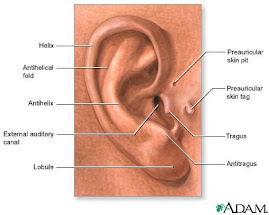Anatomy of an Inner Ear Infection
 The Eustachian tube is a canal that connects the middle ear to the throat. It is lined with mucus, just like the nose and throat; it helps clear fluid out of the middle ear and into the nasal passages. Cold, flu, and allergies can irritate the Eustachian tube and cause the lining of this passageway to become swollen.
The Eustachian tube is a canal that connects the middle ear to the throat. It is lined with mucus, just like the nose and throat; it helps clear fluid out of the middle ear and into the nasal passages. Cold, flu, and allergies can irritate the Eustachian tube and cause the lining of this passageway to become swollen.Ear Infections: All Too Common
Ear infections are extremely common, especially in runny-nosed kids. The latest research indicates that when young children get colds, they end up with an ear infection 61% of the time. Keep reading to find out why.
Diagnosing an Ear Infection
Doctors usually diagnose an ear infection by looking at the outer ear and the eardrum with a device called an otoscope. A healthy eardrum (shown here) appears transparent pinkish-gray. An infected eardrum looks red and swollen.
Fluid in the Ear
If the Eustachian tube becomes blocked, fluid builds up in the middle ear. This creates a haven for bacteria and viruses, which can cause infection. Doctors can detect fluid in the middle ear with a pneumatic otoscope. This device blows a small amount of air at the eardrum, making the eardrum vibrate. If fluid is present, the eardrum will not move as much as it should.
Ruptured Eardrum
When too much fluid builds up in the middle ear, it can put pressure on the eardrum until it ruptures (shown here). Signs of a ruptured eardrum include yellow, brown, or white fluid draining from the ear. Pain may disappear suddenly because the pressure of the fluid on the eardrum is gone. Although a ruptured eardrum sounds frightening, it usually heals itself in a couple of weeks.
Ear Infection Symptoms
The hallmark of an acute ear infection is sudden, piercing pain in the ear. The pain may be worse when lying down, making it difficult to sleep. Other symptoms include:
* Trouble hearing.
* A fever of up to 104 degrees.
* Tugging or pulling at one or both ears.
* Fluid drainage from ears.
* Loss of balance.
* Nausea, vomiting, or diarrhea.
* Congestion.
Ear Tubes
If your child has recurrent ear infections or fluid that just won't go away, hearing loss and a delay in speech may be a real concern. One solution is for your doctor to insert small tubes through the eardrum. Ear tubes let fluid drain out of the middle ear and prevent fluid from building back up. This can decrease pressure and pain, while restoring hearing. The tubes are usually left in for 8 to 18 months until they fall out on their own.
Source : MedicineNet.com
.









